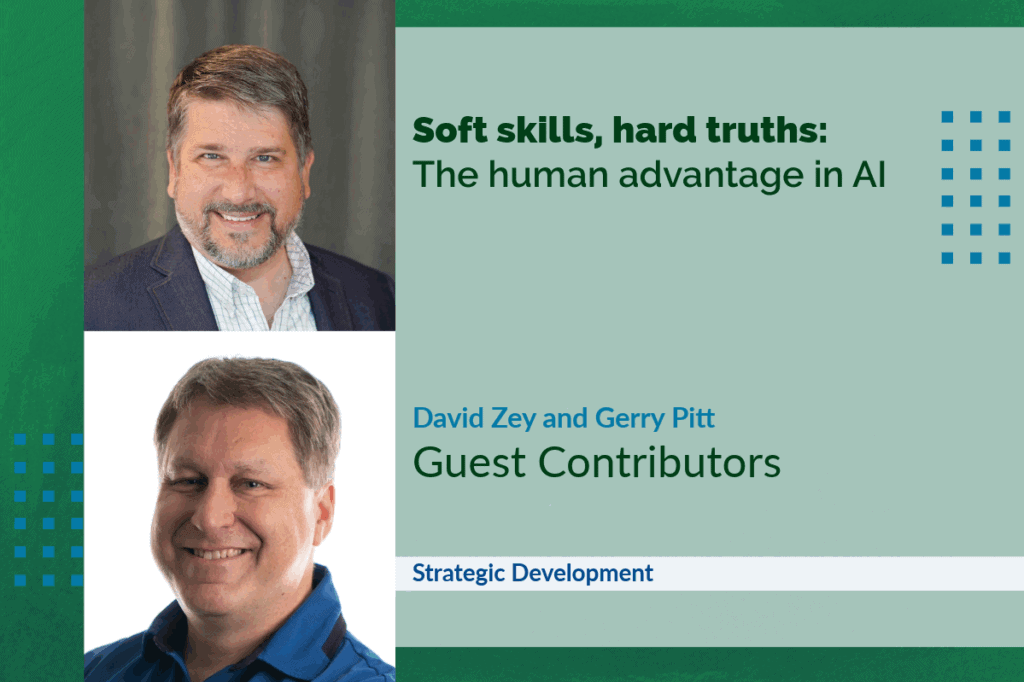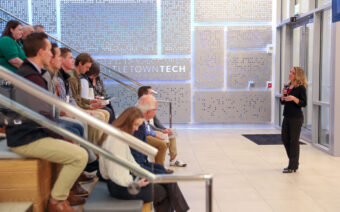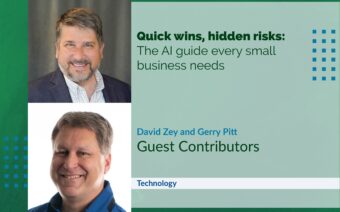
July 28, 2025
As artificial intelligence (AI) becomes a common presence across industries, a common truth is also emerging.
Though machines are becoming faster, smarter and more capable, human intelligence, especially in its softer forms, is becoming increasingly vital.
The rise of AI is not a story of replacement, but of recalibration.
It’s a call to redefine the way we work and collaborate, combining the scalable precision of machines with the irreplaceable insight, empathy and adaptability of people.
Humans play a critical role in the AI era – not just as overseers or operators of machines but as strategic thinkers, ethical leaders and creative problem-solvers.
As organizations navigate the shifting landscape of digital transformation, their ability to unlock value from AI will depend on how well they cultivate and integrate human strengths alongside technological advancement.
A new division of labor
Artificial intelligence excels in tasks that are structured, repetitive and data-intensive.
Whether it’s processing millions of data points, identifying patterns or summarizing documents, AI offers speed and scale that far exceed human capacity.
However, it does so within the limits of its training and algorithms.
It cannot reason abstractly, exercise empathy or imagine beyond what it’s been taught.
This delineation is reshaping the workplace.
AI takes over mechanical and analytical tasks, while humans are left to manage ambiguity, foster relationships and make judgment calls.
The result is not just a new division of labor, but a redefinition of what makes human workers valuable.
Rather than rendering human contributions obsolete, AI amplifies the importance of soft skills – those interpersonal and cognitive abilities that are difficult to measure but critical to success.
Communication, emotional intelligence, creativity, ethical reasoning and teamwork are essential for navigating and leading AI-infused environments.
The smartest organizations won’t pit humans against machines, but instead, they’ll team them up.
Let AI handle the heavy lifting while humans bring insight, empathy and judgment.
That’s not just a division of labor – it’s a power duo.
Why soft skills are the new power skills
Traditionally considered secondary to technical expertise, soft skills are now viewed as essential to operational excellence.
In fact, as AI systems become more capable, the capacity to communicate clearly, interpret complex human needs and solve unstructured problems has emerged as a competitive differentiator.
Several core soft skills stand out in this transformation:
- Emotional intelligence allows individuals to understand and manage both their own emotions and those of others. This becomes especially important in teams managing change or collaborating across human-machine boundaries. It also helps discern if AI is representing the voice and tone of teams and the company appropriately.
- Critical thinking is necessary to interpret AI outputs, assess risks and make decisions based on more than just data.
- Adaptability enables workers to shift gears as technology evolves and roles become more fluid.
- Communication bridges the gap between human and machine-generated insights, ensuring shared understanding across stakeholders.
- Collaboration supports the creation of cross-functional teams where humans and AI each play to their strengths.
These skills don’t just smooth interpersonal dynamics – they close the gap between humans and AI, driving innovation, improving customer experiences and strengthening culture.
Humans in the loop: Essential, not optional
The concept of “human-in-the-loop” (HITL) has gained prominence as AI adoption scales.
HITL refers to systems where human oversight remains integral to decision-making, particularly in scenarios where nuance, ethical considerations or contextual awareness are needed.
This is more than a safety net.
When humans engage directly with AI systems, reviewing outputs, refining models and injecting real-world context, they elevate the technology’s effectiveness.
For instance, human feedback can help detect bias in training data, validate model accuracy in edge cases and ensure relevance in outputs.
Without this layer of human refinement, AI systems risk generating flawed or even harmful results.
AI can automate the identification of patterns, but it takes a human to understand why those patterns matter and when they don’t.
A machine might flag a correlation, but a person must assess causation, interpret meaning and determine the right course of action.
In this way, AI becomes a tool that augments rather than replaces human judgment.
Including humans in the loop also fosters trust.
Employees and customers alike are more likely to embrace AI when they know there is thoughtful human oversight guiding its decisions.
Feed the machine: The hidden human effort
One of the paradoxes of modern AI is that though it promises automation, it demands a significant amount of human input, especially in its early stages.
Behind every useful AI tool is a meticulously curated and continuously updated knowledge base.
And yet, AI success doesn’t depend on perfectly clean data.
It depends on situational clarity, just like a human does.
By the time you’ve cleaned and structured the data to perfection, you may have already scripted the outcome, leaving little room for the AI to learn, adapt or surprise you.
In generative systems, rigidity doesn’t just limit creativity – it makes the output feel obvious and flat, as if the model is echoing a formula rather than generating something new.
That’s why human involvement remains essential.
Not just in labeling or cleaning, but in shaping the context, exceptions and intent behind the data.
This is especially true for business-specific solutions.
Feeding the machine isn’t about perfection – it’s about relevance, judgment and perspective, the things only people can provide.
The most effective AI efforts pair domain insight with intentional AI engineering of context, ensuring the output reflects the messy reality it’s meant to support.
Ethical leadership in an automated age
As AI systems begin to influence decisions with wide-reaching implications, from hiring to health care, finance to criminal justice, the need for ethical oversight grows.
Machines are not moral agents.
On their own, they don’t ask whether they should do something, only whether they can.
That responsibility rests with humans.
Leadership in the AI age requires more than technological competence.
It demands an ethical compass, a commitment to transparency and the courage to make decisions that serve not just shareholders but society as a whole.
Ethical decision-making in AI involves questions like:
- Is this model trained on fair and representative data?
- Could the outcome disadvantage a particular group?
- Who is accountable when the system fails?
- Is the system explainable or is it a black box?
- Can impacted users appeal to its decisions?
These are not technical problems – they are human ones.
Organizations that foster a culture of ethical awareness, critical inquiry and inclusive thinking will be better equipped to harness AI responsibly and sustainably.
Designing human-centric AI systems
The most effective AI systems are those built with humans in mind from the start.
This goes beyond intuitive interfaces or process automation.
It means designing tools that respond to real human needs, and that can evolve as those needs change.
It requires thoughtful integration, constant feedback and a willingness to adapt.
But human-centered AI isn’t only about meeting people where they are; there’s a creative tension at play.
AI must evolve in response to human behavior, and it must challenge the outdated ways we’ve come to meet our needs.
Sometimes the problem isn’t what we’re doing, but how we’re doing it.
AI can introduce new, more efficient or more humane ways to reach the same goals.
The challenge is making sure disruption serves a purpose, not novelty.
As AI handles more of the “how,” it brings the “what” and “why” into sharper focus.
The mechanics of execution fade into the background, revealing the deeper human drivers: purpose, intention and meaningful outcomes.
Though AI may transform the way things get done, it can’t decide what should be done or why it matters.
The “what” and “why” are for humans to decide.
True human-centered design requires collaboration.
Developers, designers, domain experts, ethicists and end users must all have a hand in shaping these tools.
When people feel AI is designed to work with them – not around them – they’re more likely to adopt it, improve it and trust it to move with them into the future.
Soft skills as strategic imperatives
Embedding soft skills into the fabric of organizational development requires intention and investment.
It’s not enough to offer occasional workshops.
Businesses need systemic approaches to cultivating these capabilities.
Some effective strategies include:
- Blending soft skills with technical training: Pairing technical upskilling with modules on communication, ethics and teamwork reinforces the idea that both sets of skills are equally valuable.
- Simulation and scenario-based learning: Case studies and role-playing exercises provide a sandbox for practicing judgment, empathy and collaboration.
- Feedback-rich environments: Continuous coaching and mentoring help individuals grow in areas like emotional intelligence and adaptability.
- Ethical frameworks: Embedding ethical reasoning into AI development processes ensures that human values are central to technological decision-making.
- Cross-functional teams: Bringing together diverse perspectives enhances collective problem-solving and supports holistic thinking.
In this environment, soft skills aren’t peripheral – they’re strategic assets that fuel innovation, mitigate risk and build trust.
However, cultivating them requires more than good intentions, especially in remote and hybrid work settings, where casual interactions and informal mentorship are harder to sustain.
When done well, these skills become part of the culture regardless of where the work is done.
A call to reimagine the workforce
The future of work won’t be a binary choice between humans and machines.
It will be a dynamic, evolving partnership.
One where the best outcomes come from thoughtfully combining the unique strengths of both.
For businesses, this means cultivating a workforce that is both technologically fluent and deeply human.
For individuals, it means embracing lifelong learning, nurturing emotional and ethical intelligence and finding new ways to add value in hybrid human-AI environments.
This transformation is already underway.
Jobs are being redefined.
New roles are emerging.
Though some tasks will fade, others will flourish, especially those which require imagination, intuition and interpersonal skills.
Organizations that recognize this and build talent development strategies accordingly will position themselves not just to survive, but to lead in the AI era.
A culture of continuous learning
Thriving in an AI-enabled world requires more than skill acquisition – it requires a mindset shift.
Companies should nurture a culture of curiosity, experimentation and feedback, such as:
- Encourage employees to question and test AI outputs
- Support cross-training between technical and non-technical teams
- Provide access to ongoing education on AI tools, ethics and applications
- Recognize and reward adaptability and problem-solving
In such cultures, mistakes are seen as learning opportunities, and success is measured not only by efficiency but also by growth and resilience.
Leading with humanity
In a landscape defined by rapid technological advancement, the defining advantage is not code, computation or connectivity.
It’s character.
It’s the uniquely human capacity to care, create and connect that will guide AI toward outcomes that are meaningful, responsible, and enduring.
As we look toward a future where AI becomes ever more integrated into our lives and work, the imperative is clear: We must invest not only in machines but in the people who will use them.
The organizations that thrive will be those that put humans, not just in the loop, but at the center of their AI strategies, where they belong.
By mastering the art of human-AI collaboration, we unlock a future where technology enhances our humanity, rather than diminishes it.
And that is a future worth building on.
 Walkable communities on the rise
Walkable communities on the rise New mapping tool shows gaps in broadband coverage
New mapping tool shows gaps in broadband coverage







